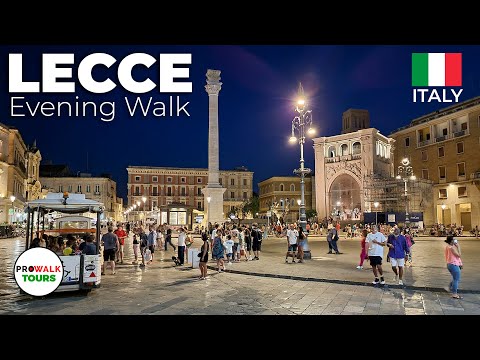Lecce - The Florence of the South - Evening Walk - 4K - With Captions

Welcome to Lecce, Italy. We enter the city center through the Porta Rudiae, a historic entrance gate that was rebuilt in the 18th century. Topping the four columns are busts of the mythical founders of the city, Malennio, Dauno, Euippa and Idomeneo. Legend says that Malennio, the mythological king of Salento, founded the city in 1200 BC after the destruction of Troy.
Malennio supposedly named the city after Lycia, Idomeneo’s homeland. This ornately decorated church is an example of the Baroque style of architecture for which Lecce is renowned. The building was constructed by the architect Giuseppe Zimbalo between 1691 and 1728. The interior has several highly decorated altars and statues made from “Lecce stone”, a particular kind of limestone that is very soft so suitable for carving. There was originally intended to be a dome but the architect died before it could be completed.
On the pilasters around the walls there are coats of arms of the families that commissioned the church’s construction. Lecce is located in southern Italy in the region of Apulia. It is the main city of the Salentine peninsula, at the heel of the Apulia region. The Church of St Anne is another example of Baroque architecture, built in 1680, although it is somewhat plainer than many of the city’s other churches.
According to the founding legend, the city was originally called Sybar and was inhabited by the Messapians, a tribe living in Salento in classical antiquity. The Messapians are recorded as Cretans by the Greeks, and traces of the Greek culture they brought to the area are still present. Near Lecce, there is a collection of towns in the Grecia Salentina where the population is ethnically Greek and the local dialect, Griko, derives from Greek. In the 3rd century BC, Romans conquered the city and gave it the new name of Lupiae. During Emperor Hadrian’s rule in the 2nd century AD, the city was shifted 3 kilometers to the northeast. At this time it was also given the name Licea or Litium.
Under the Romans, a theater and amphitheater were built in the city and it was connected to what was known as Hadrian’s Port, now San Cataldo. The Piazza del Duomo is one of Lecce’s Baroque showpieces. It is unusual as a square because it is closed on all four sides with just one entrance.
The principal entrance to the cathedral lies on the northern façade. This monumental entrance is a Baroque masterpiece with niches containing statues of Saint Giusto and Saint Fortunato and an ornate balustrade above which Saint Orontius stands beneath a grand arch. The western facade, instead, is divided into three sections corresponding with the three naves in the interior. The right side is slighted concealed by the adjacent building, which is the Archbishop’s Palace. Construction first began on the cathedral in 1144 but it was rebuilt in 1659 by Giuseppe Zimbalo.
The bell tower was built between 1661 and 1662 also by Giuseppe Zimbalo, who was from Lecce. The cost to enter the Duomo is €6, or you can spend €9 and get access to a total of six sites in the historic center. Tickets are available online or at the ticket office in the Piazza del Duomo. Residents of Lecce are exempt from needing a ticket. Saint Orontius is honored in the cathedral because he is the patron saint of the city of Lecce.
He is known as the city’s first Christian bishop. According to legend, he refused to worship the Roman gods and continued to preach as a Christian even when persecuted by the authorities. This was once a convent built during the Baroque period. It is now used as a space for concerts and other performances. Saint Orontius was executed with an axe just outside the city of Lecce on August 26. August 26 is now celebrated as his feast day with a three-day festival.
When the Western Rorman Empire fell, Lecce was invaded by the Ostrogoth king Totila who sacked the city as part of the Gothic Wars. Lecce does not have many "must see" kind of sites, but instead, people visit to wander the narrow streets and enjoy the architectural beauty as they dine in one of the many piazzas. This church on our left was built between 1591 and 1639.
It was in this church that the referendum vote was held to decide whether Lecce would enter the Kingdom of Italy. Although Saint Orontius is now the patron saint of Lecce, until 1656 the patron saint was Saint Irene. Pope Alexander VII changed the patron saint because he wanted a bishop saint.
In 549, the city came under the Romans again and remained part of the Eastern Roman Empire for five centuries. The church on the right was built in the 16th century to serve the Venetian community in the city. The patron saint of Venice is Saint Mark. The Roman amphitheater seems sunken in the grown because buildings were constructed on top of it over the years.
The amphitheater was constructed between the 1st and 2nd centuries AD under Emperor Augustus. It would once have held 25,000 spectators. Just based on the ruler tool on Google earth, the width of the arena floor is about 111 ft, while the Colosseum in Rome is around 155ft across. While part of the Eastern Roman Empire, Lecce suffered invasions and brief conquests by the Saracens and Lombards. The city was also ostensibly neglected as nearby Otranto gained importance.
This square is named after the first King of Italy. The church of Santa Chiara is one of the city’s important Baroque monuments. The church was built between 1687 and 1691 and is characterized by rich decoration both internally and externally. Up ahead is another Roman theater that is often unseen by tourists because it is located away from the main sites. This theater was also built during Emperor Augustus’s reign. It was discovered by chance in 1992 when work was being carried out in the gardens of two historic palaces.
It is possible that Augustus commissioned the theater and amphitheater to give thanks to the city when he found refuge there before becoming emperor. In the 11th century, the Normans took over the city. Under the Normans, Lecce began to revive as a city and gained importance as a commercial and political center. The city also thrived under the later Hohenstaufen and Angevine rule. This church, built between 1667 and 1700 by Giovanni Andrea Larducci, is another Baroque masterpiece.
The Baroque buildings in this city share particular characteristics that mean the style has become known as “Barocco Leccese”. Lecce became a county and was annexed to the Kingdom of Sicily in the 11th century. As part of the Kingdom of Sicily, the County of Lecce was one of the most important and biggest fiefs until 1463. By the 15th century, Lecce had become one of the most important cities in the whole of southern Italy.
In the 16th century, Lecce came under the rule of Charles V, Holy Roman Emperor. The 16th century saw the city under attack from the Ottomans. To rebuff the Ottomans, Charles V ordered new protective walls to be built in the first half of the 16th century.
He also ordered the construction of a castle and fortifications along the coastline. This square is home to the Chiesa del Gesù, built between 1575 and 1699, with a richly decorated high altar in the typical style of Lecce baroque architecture. The Basilica di Santa Croce is the city’s Baroque masterpiece, with a facade so ornately decorated it looks almost like lace. The facade is richly decorated with animals, vegetation and grotesque figures.
The animals and figures beneath the balustrade represent the Christian families that participated in the Battle of Lepanto. The dragon symbolizes the Boncompagni, the family of Pope Gregory XIII, the griffon represents the Republic of Genoa, and Hercules stands for the Grand Duke of Tuscany. On either side of the main door are the coasts of arms of Philip III of Spain, Mary of Enghien and Walter VI of Brienne.
Under Countess Mary of Enghien, the city received its first constitutional statute and its first castle. At this time, connections were reformed with the Venetian Republic in order to trade goods. Next to the Basilica is the Palazzo della Provincia, another baroque building. Saint Orontius is credited with saving the inhabitants of Lecce from the plague that devastated the kingdom of Naples in 1566.
Because of the city’s importance, starting in 1630 the urban center began to be enriched with monumental Baroque buildings. In 1639, bishop Luigi Pappacoda was called to take over the diocese of Lecce. Pappacoda was responsible for commissioning several of the city’s most significant churches including the Church of San Matteo we just saw. The magnificent constructions of the Baroque period earned the city the nickname “Florence of the South”.
In 1656, Lecce was hit by an outbreak of the plague that killed 1,000 inhabitants. This church was built between 1703 and 1744 and is considered to be one of the most “plain” facades in the city. This triumphal arch is one of the historic entrance gates into the city. The archway was built in 1548 in honor of Charles V and the defensive structures he commissioned for the city. In the center of the triangular pediment, there is the coat of arms of Charles V.
The gateway was built on the site of an older entrance, Porta San Giusto. This street is named after Giuseppe Palmieri, an Italian economist and politician living during the 18th century who studied in Lecce. Lecce played an important role during World War II. Fighter aircraft based in the city aided isolated Italian garrisons in the Aegean sea in 1943.
The 15th US Air Force also had a base in Italy and flew from there over Italy, the Balkans, Germany, France and Austria. Built in 1943 by United States Army Engineers, the airfield was primarily a Fifteenth Air Force B-24 Liberator heavy bomber base used in the strategic bombing of Germany. This is the tiny church of Santa Maria della Pace built in 1738. This is the elegant Palazzo Palmieri. It is open to visitors and in the garden, there are archeological remains of the city’s Messapian beginnings. The city of Lecce now has nearly 96,000 inhabitants. The city is home to an important university, the University of Salento, which was founded in 1955.
It enrolls more than 16,000 students a year. The “Lecce stone”, responsible for the characteristic rich carving and sculptures on the city’s Baroque monuments, is also one of its main exports. Because the stone is soft and malleable, it is easy to work but it is also prone to deterioration.
The city is now a very popular tourist destination for its magnificent architecture and nearby coastline. While in Lecce, I made day trips to Gallipoli and Otranto, both of which are only 35 minutes away. Visiting Lecce in the 18th century, traveler Thomas Ashe called it “the most beautiful city in Italy”.
Lecce remains an important agricultural center producing olive oil and wine. Tragically, the olive trees in this area have been suffering a deadly bacterium, xylella fastidiosa. Lecce is one of the worst-hit areas, with millions of olive trees killed. Other typical products include bread, such as crunchy friselle and soft puccia. After this walk, I went to a restaurant I had seen while exploring the town and had a meat and cheese board, known in Italy as a charcuterie board.
This is the coat of arms of the city featuring a wolf and an oak tree. The tall column, 29 meters high, honors Saint Orontius and was erected in 1666. Lecce is also famous for its ceramic production and there are many artisan workshops around the city. We end our walk at the Teatro Apollo, a monumental neoclassic theater built in 1912 and reopened to the public in 2017.
Thanks for watching!
2021-11-17 01:45


